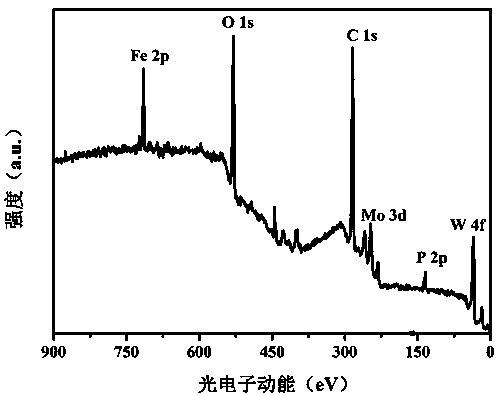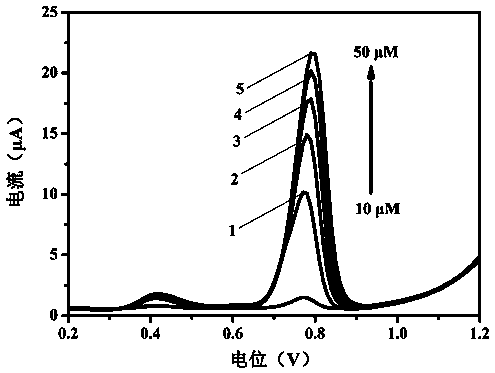An electrochemical sensing electrode based on ferrocene-heteropolyacid/graphene
A sensing electrode and heteropoly acid technology, applied in the field of electrochemical sensing electrodes, can solve the problems of poor sensitivity and slow detection speed, achieve the effect of improving electrocatalytic performance and solving slow detection speed
- Summary
- Abstract
- Description
- Claims
- Application Information
AI Technical Summary
Problems solved by technology
Method used
Image
Examples
specific Embodiment approach 1
[0018] Specific embodiment one: a kind of electrochemical sensing electrode based on ferrocene-heteropolyacid / graphene of this embodiment is characterized in that a kind of electrochemical sensing electrode based on ferrocene-heteropolyacid / graphene The electrode is composed of GCE electrode and Fc-PMo coated with GCE electrode 6 W 6 / RGO composite film, from the GCE electrode to the outer layer is Fc-PMo 6 W 6 : Ferrocene-phosphomolybdenum tungsten heteropolyacid complex layer, RGO: reduced graphene oxide layer.
specific Embodiment approach 2
[0019] Specific embodiment two: the difference between this embodiment and specific embodiment one is: the described a kind of electrochemical sensing electrode based on ferrocene-heteropolyacid / graphene is characterized in that the ferrocene-heteropolyacid / graphene In the complex layer of phosphomolybdenum tungsten heteropoly acid, the heteropoly acid is Keggin type phosphomolybdenum tungsten heteropoly acid, the molecular formula is H 3 PMo 6 W 6 o 40 mH 2 O, m=36~42; the molar ratio of ferrocene to heteropolyacid is 1: (6~8). Other steps and parameters are the same as those in the first embodiment.
specific Embodiment approach 3
[0020] Specific embodiment three: The difference between this embodiment and specific embodiment one or two is that the complex layer of the ferrocene-phosphomolybdenum tungsten heteropolyacid is modified by GCE electrode at a concentration of 10mol / L~12mol / L ferrocene-phosphomolybdenum tungsten heteropoly acid solution, the modification time is 20min~25min. Other steps and parameters are the same as those in Embodiment 1 or 2.
PUM
 Login to View More
Login to View More Abstract
Description
Claims
Application Information
 Login to View More
Login to View More - R&D
- Intellectual Property
- Life Sciences
- Materials
- Tech Scout
- Unparalleled Data Quality
- Higher Quality Content
- 60% Fewer Hallucinations
Browse by: Latest US Patents, China's latest patents, Technical Efficacy Thesaurus, Application Domain, Technology Topic, Popular Technical Reports.
© 2025 PatSnap. All rights reserved.Legal|Privacy policy|Modern Slavery Act Transparency Statement|Sitemap|About US| Contact US: help@patsnap.com



